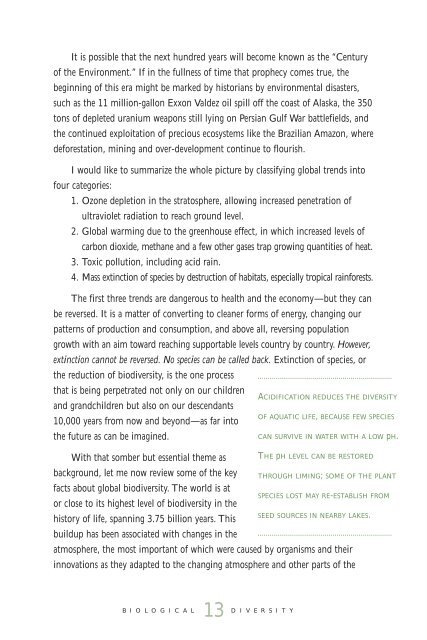Download Biological Diversity - New York State Museum
Download Biological Diversity - New York State Museum
Download Biological Diversity - New York State Museum
Create successful ePaper yourself
Turn your PDF publications into a flip-book with our unique Google optimized e-Paper software.
It is possible that the next hundred years will become known as the “Century<br />
of the Environment.” If in the fullness of time that prophecy comes true, the<br />
beginning of this era might be marked by historians by environmental disasters,<br />
such as the 11 million-gallon Exxon Valdez oil spill off the coast of Alaska, the 350<br />
tons of depleted uranium weapons still lying on Persian Gulf War battlefields, and<br />
the continued exploitation of precious ecosystems like the Brazilian Amazon, where<br />
deforestation, mining and over-development continue to flourish.<br />
I would like to summarize the whole picture by classifying global trends into<br />
four categories:<br />
1. Ozone depletion in the stratosphere, allowing increased penetration of<br />
ultraviolet radiation to reach ground level.<br />
2. Global warming due to the greenhouse effect, in which increased levels of<br />
carbon dioxide, methane and a few other gases trap growing quantities of heat.<br />
3. Toxic pollution, including acid rain.<br />
4. Mass extinction of species by destruction of habitats, especially tropical rainforests.<br />
The first three trends are dangerous to health and the economy—but they can<br />
be reversed. It is a matter of converting to cleaner forms of energy, changing our<br />
patterns of production and consumption, and above all, reversing population<br />
growth with an aim toward reaching supportable levels country by country. However,<br />
extinction cannot be reversed. No species can be called back. Extinction of species, or<br />
the reduction of biodiversity, is the one process<br />
that is being perpetrated not only on our children<br />
and grandchildren but also on our descendants<br />
10,000 years from now and beyond—as far into<br />
the future as can be imagined.<br />
With that somber but essential theme as<br />
background, let me now review some of the key<br />
facts about global biodiversity. The world is at<br />
or close to its highest level of biodiversity in the<br />
history of life, spanning 3.75 billion years. This<br />
buildup has been associated with changes in the<br />
ACIDIFICATION REDUCES THE DIVERSITY<br />
OF AQUATIC LIFE, BECAUSE FEW SPECIES<br />
CAN SURVIVE IN WATER WITH A LOW pH.<br />
THE pH LEVEL CAN BE RESTORED<br />
THROUGH LIMING; SOME OF THE PLANT<br />
SPECIES LOST MAY RE-ESTABLISH FROM<br />
SEED SOURCES IN NEARBY LAKES.<br />
atmosphere, the most important of which were caused by organisms and their<br />
innovations as they adapted to the changing atmosphere and other parts of the<br />
B i o l o g i c a l<br />
13 D i v e r s i t y
















